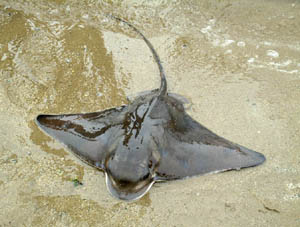 | |||||||||||
|
|
|
|
|
|
|||||||
|
| |||||||||||
|
Elkhorn Slough Elasmobranch Project The bat ray is the largest and heaviest elasmobranch in the Elkhorn Slough system and can weigh close to 200 lbs and be 5 feet across. These highly active rays crush up their prey with hard pavement like teeth. Bat rays can be found throughout the slough system with largest specimens relegated mostly to the main channel with abundant juveniles and subadults in the shallower canals, lagoons and tributaries. Bat rays prey mostly upon crabs, worms and shellfish while in the slough. The bat rays are believed to mate in the summer and give birth during the following season. Females typically weigh over 50 lbs when mature with males reaching maturity and less than half that weight. Pups are born live and come out tail first with the wings wrapped around the body. Bat ray females increase their reproductive payload as they mature; young females give birth to as few as 2 pups with larger fully matured females giving birth to as many as a dozen young. Bat rays occur from Oregon to the Gulf of California, ranging well out into the Monterey Bay, and are commonly encountered in proximity to kelp beds and rocky inshore reefs as deep as 200 feet deep. The long whip like tail is armed with a very wieldy serrated barb that can inflict repeated stab wounds if handled improperly.
|
| |
[ home ] | [ contact us ] | [ support us ] | [ shop ] | © Copyright 1990-2005 PSRF All rights reserved. |
Site Development by IT Director Content updates by |
